CAA News Today
Dawn Holder and Stephanie Lanter
posted by CAA — Apr 29, 2019
The weekly CAA Conversations Podcast continues the vibrant discussions initiated at our Annual Conference. Listen in each week as educators explore arts and pedagogy, tackling everything from the day-to-day grind to the big, universal questions of the field.
CAA podcasts are on iTunes. Click here to subscribe.
This week, Dawn Holder and Stephanie Lanter discuss evading boundaries in making meaning and teaching.
Dawn Holder is Associate Professor of Art at the University of the Ozarks, where he teaches Ceramics, Sculpture, and Art History. She has received numerous accolades for her work, and has exhibited in galleries and museums across the country, including the National Museum for Women in the Arts, where she was invited to participate in the Organic Matters: Women to Watch exhibition. She received an MFA in Ceramics from RISD and a BFA in Ceramics from the University of Georgia.
Stephanie Lanter is currently the Assistant Professor of Ceramics at Emporia State University in Kansas, where she teaches all levels of Ceramics, 3-Dimensional Design, and Fibers. She makes clay and mixed media sculpture, drawings, and texts and has been teaching for 15 years.
Affiliated Society News for April 2019
posted by CAA — Apr 11, 2019
Affiliated Society News shares the new and exciting things CAA’s affiliated organizations are working on including activities, awards, publications, conferences, and exhibitions.
WELCOME TO NEW AFFILIATED SOCIETIES
We are delighted to welcome the following organizations to CAA:
- Digital Art History Society
- William Morris Society in the United States
- International Council of Fine Arts Deans
- Association of Scholars of Christianity in the History of Art
- Association of Greek Art Historians
- Society for the History of Collecting
Interested in becoming an Affiliated Society? Learn more here.
Historians of German, Scandinavian, and Central European Art and Architecture (HGSCEA)
HGSCEA was well represented at CAA by members who presented papers and chaired sessions, and whose latest publications could be found in the book exhibition. Of particular note was our sponsored session, “Women Artists in Germany, Scandinavia, and Central Europe, 1880-1950,” chaired by Kerry Greaves. Her introductory remarks and concluding comments framed four excellent papers by Emil Leth Meilvang on Rita Kernn-Larsen, Nora Butkovich on women in the Young Yiddish Group in Poland, Lauren Hanson on Mary Bauermeister, and Lynette Roth on Anneliese Hager. On the conference’s last day, Paul Stirton offered members a special tour of the exhibition “Jan Tschichold and the New Typography,” which he curated at Bard Graduate Center.
Over sixty members, many in metallic attire for the Bauhaus centenary, attended the annual dinner. In the course of the convivial evening, the results of the 2018 Emerging Scholars Prize were announced. Anne Reimers (University of the Creative Arts Rochester, UK) received an honorable mention for “Inscribing Temporality, Containing Fashion: Otto Dix’s Portrait of the Dancer Anita Berber Contextualized,” in Art History. The winner was Greg Bryda (Barnard College), who was awarded the prize for “The Exuding Wood of the Cross at Isenheim,” in The Art Bulletin. In addition, we celebrated the achievements of Maria Makela on the occasion of her retirement. Adrian Sudhalter spoke to the impact of Maria’s scholarship, and Ricki Washton-Long reflected on her important contributions to HGSCEA.
At the business meeting, the Board amended the bylaws to ensure that in the future the Board includes representatives from all three areas that constitute HGSCEA. It also deliberated on the pool of submissions for the guaranteed session at the 2020 conference, accepting the proposal of Hyewon Yoon and Jordan Troeller, “A Foreign Eye: Photography, Women, and Global Encounters in the Twentieth Century.”
For pictures of the session, dinner, and curator’s tour, go to: http://hgscea.org/
National Council of Arts Administrators
- NCAA welcomes three new board members, Jonathan Fohrman, MiraCosta College, CA, Sarah Meyer, California Poly Pomona, and Michael Wille, Illinois State University to the NCAA Board of Directors.
The current list of board members include:
Lynne Allen, Boston University
President
Elissa Armstrong, Virginia Commonwealth University
Past President
Peter Chametzky, University of South Carolina
Secretary
Cathy Pagani, The University of Alabama
Treasurer
Andrea Eis, Oakland University
Past Treasurer
Colin Blakely, University of Arizona
Jeni Mokren, SUNY New Paltz
A.Blake Pearce, Valdosta State University
Joe Poshek, Irvine Valley College
Michael Fels, Elon University
Jade Jewett, California State University, Fulteron
David LaPalonbara, Ohio University
- The next NCAA conference will be hosted by Kate Bonansingakn, University of Cincinnati, Matt Albritton, Northern Kentucky University and Paige Williams, Art Academy of Cincinnati. We hope to see everyone in Cincinnati September 17-22,2019! Check it out on our website.
- It is with great pleasure that we open our NEW website which offers news of the upcoming conference, current open positions, and access to other resources. Please check it out https://www.ncaaarts.org
Association for Latin American Art

ALAA Reception at Orange Door Chicago (Marilynn and Carl Thoma Gallery). Pictured left to right: Marilynn Thoma, Erin Fowler (Director of Strategic Initiative, Thoma Art Foundation), Delia Cosentino (Triennial Chair)
The Association for Latin American Art hosted its 5th Triennial Conference “The World Turned Upside Down: Arts of Oppression and Resistance in the American Hemisphere” from March 7-9, 2019 at the Art Institute of Chicago and DePaul University. In addition to a wonderful selection of panels, the conference included tours of the Smart Museum’s holding of Latin American art at the University of Chicago and the exhibition Super/Natural: Textiles of the Andes at the Art Institute of Chicago, a keynote lecture “Social Disequilibria: of Bodies and Borders” by Dr. Adriana Zavala, Tufts University, at the National Museum of Mexican Art, and a reception at the Orange Door Chicago (Marilyn and Carl Thoma Gallery). https://associationlatinamericanart.org/triennial/

Art Institute of Chicago’s Elizabeth Pope & Erica Warren Tour of Super/Natural: Textiles of the Andes
Appraisers Association of America
15th Annual Award Luncheon honoring cultural anthropologist, author and museum director Johnnetta Betsch Cole, Ph.D., and visual artist Mickalene Thomas, whose work of African American women examine, extend, and subvert concepts of female identity and beauty.Dr. Cole and Ms. Thomas will be presented with the 2019 Award for Excellence in the Arts on Wednesday, April 17, 2019 at the New York Athletic Club.
For tickets and sponsorship opportunities please click here. Or by calling 212-889-5404 x11.
ASSOCIATION FOR TEXTUAL SCHOLARSHIP IN ART HISTORY (ATSAH)
Announcement Award
Prof. Damiano Acciarino, Univerisità Ca’ Foscari Venezia and University of Toronto, who holds A Marie Curie Global Fellowship (2017-2020) was the first recipient of ATSAH award for his innovative and scholarly research on Renaissance antiquarianism published in Lettere sulle Grotteche (Rome: Aracne, 2018).
Professional Recognition
Liana De Girolami Cheney, President of ATSAH, received the Albert Nelson Marquis Lifetime Achievement Award
William Levin contributes a second award to SECAC for scholarly Research in the History of Art Since 1750. The previous award was for Research in the History of Art Before 1750.
Member’s publications
Sara Nair James. “Wit and Humor in Ugolino di Prete Ilario’s Life of the Virgin at Orvieto,” Source: Notes in the History of Art vol 36, no.3-4 (Spring/Summer 2017), 159-67.
Davide Lacagnina, “Spreading Visual Culture: revues, images et archives pour l’art contemporain,” In H.V. E. Stead, ed L’Europe des revues II (1860-1930). Réseaux et circulations des modèles (PARIS: PUPS-Presses de l’université Paris-Sorbonne, 2018), pp. 829-852.
Émilie Passignat, “‘Manière’, ‘maniéré’, ‘maniériste’: transferts et enjeux théoriques autour d’un terme clé du vocabulaire artistique”, in M.-C. Heck, M. Freyssinet, S. Trouvé (eds.), Lexicographie artis- tique: formes, usages et enjeux dans l’Europe moderne, Montpellier, 2018, pp. 363-376.
Liana De Girolami Cheney, “Il Tesoretto of Cosimo I de’ Medici: An Esoteric Heaven,” in Lilian Zirpolo, ed. Esoteric Traditions and Their Impact on Art (Ramsey, NJ: Zephyrus Scholarly Publications LLC, 2019) (ISBN number: 978-0-997-2446-2-5)
Liana De Girolami Cheney, “Edward Burne-Jones’s The Mirror of Venus: Physical and Intangible Female Beauty,” Journal of Literature and Art Studies, Vol. 19, No. 1 (January 2019):1-28.
IN MEMORIAM (April 29, 2019)
Sarah Jordan Lippert (1975-2019), Associate Professor of Art History at the University of Michigan-Flint, Director of the Society for Paragone Studies, Editor-in-Chief of its journal Paragone: Past and Present passed away on April 24, 2019. She was the author of numerous books and articles including the newly published The Paragone in Nineteenth-Century Art (Routledge 2019), along with Going Back to the Beginning of Things: The Ancient Origins of the Arts of France (Taylor and Francis, UK 2018), and The Temporality of Imitation in the Works of Moreau and Gérome (Tauris, UK, 2017): https://umflint.academia.edu/SarahLippert/Books
Sarah was long-time supporter and member of ATSAH, SECAC and CAA.
The SECAC 2019 session in Chattanooga, she was to chair at the upcoming conference, The Art of Depicting Paragoni of Life, will go forward in honor of her memory as well as special session at CAA in 2020
We are grateful to have known and loved this young, energetic, and accomplished scholar. ATSAH plans to establish an academic fund in her honor. Details will follow.
American Institute for Conservation
We are proud to announce that we have launched a new name, look, and message for AIC and FAIC! The American Institute for Conservation of Historic and Artistic Works is now simply the American Institute for Conservation. The foundation is now the Foundation for Advancement in Conservation. The acronyms are the same, but our message is more direct: we preserve and protect cultural heritage. We’re reinforcing this message with a new online presence: www.culturalheritage.org. AIC President Margaret Holben Ellis explains the necessity of our new identity in this video. We welcome you to explore our new online presence and let us know what you think. You can provide feedback via email to info@culturalheritage.org.
Throughout this process, we considered how we could make our field more welcoming and engaging to all practitioners in the arts, humanities, and allied professions. We would like to invite everyone to learn more about conservation and support the essential work performed by conservators and preservation professionals. Friends of Conservation receive exclusive insights into conservation while sustaining programs that promote the preservation of cultural heritage through their gift to FAIC. Learn about the benefits of being a Friend and how you can help support the work of conservators here: www.culturalheritage.org/friends.
Women’s Caucus for Art
Call for Panel Proposals at CAA
Women’s Caucus for Art invites submissions for a panel to be held at the CAA conference in Chicago. WCA hosts a conference concurrent with CAA, with some panels happening on site at CAA, and our 2020 theme is Intersectionality. Sessions are 90 minutes and may take the form of panels or roundtable discussions. We welcome submissions of topics for an open call as well as submissions with panel participants already identified.
To apply, please send panel title, 250-word abstract, and short CV to WCA President Margo Hobbs, at margohobbs@muhlenberg.edu
Proposals are due April 21, 2019. Selections will be made by the WCA Executive Board and the Conference Committee. Applicants will be notified of decisions by April 28, 2019.
Digital Art History Society
The new Digital Art History Society (DAHS), launched on January 1, 2019, inspired by “Art History in Digital Dimensions,” hosted in October 2016 by the Department of Art History and Archaeology and the Maryland Institute for Technology in the Humanities (MITH), University of Maryland, College Park, with support from the Getty Foundation and the Samuel H. Kress Foundation (see: http://dah-dimensions.org/).
The Digital Art History Society (DAHS) supports art historical scholarship incorporating and benefitting from digital strategies and technologies. Its website (https://digitalarthistorysociety.org) and listserv promote communication about resources and opportunities for its members. Membership in 2019 is free; dues will subsequently increase to $25.00 to defray administrative costs.
DAHS presented “Constructing Criticality in Digital Art History,” at CAA’s 2019 meeting (https://caa.confex.com/caa/2019/meetingapp.cgi/Session/2249.) Its 2020 session will examine new scholarship enabled by digital techniques and strategies. DAHS looks forward to collaborating with other CAA Affiliates.
Founding Board: President, Anne Collins Goodyear; Vice President for Programming: Pamela Fletcher; Vice Presidents for Outreach: Deena Engel and Charles R. Johnson; Vice Presidents for Membership: Meredith Gill and Paul Jaskot; Vice Presidents for Communications: Jennifer Henel and Ellen Prokop; Treasurer: Anne Helmreich.
Upcoming events (free,but online registration is required. Please visit frick.org/programs/library to register. Meet at 1 East 70th Street, NYC):
Lecture: “Artist Archives Initiative: New Research Models for Contemporary Artists,” Thursday, May 2, 4:00 p.m. to 6:00 p.m. The Frick Collection and Frick Art Reference Library, New York. Deena Engel, Clinical Professor, Computer Science, NYU, and Glenn Wharton, Clinical Professor, Museum Studies, NYU.
Workshop: “The Lenox Library Picture Gallery: A Digital Recreation,” Wednesday, June 5, 4:00 p.m. to 6:00 p.m. The Frick Collection and Frick Art Reference Library, New York. Sally Webster, Professor Emerita, Lehman College and the Graduate Center, CUNY, and David Schwittek.
Midwest Art History Society
The Midwest Art History Society (MAHS) recently concluded its annual conference in Cincinnati where participants were warmly welcomed by local institutions — especially the Cincinnati Museum of Art (CAM) and the Taft Museum of Art which both hosted scholarly sessions. The keynote lecture was delivered by S. Hollis Clayson, Bergen Evans Professor in the Humanities at Northwestern University, in association with CAM’s exhibition Paris 1900: City of Entertainment featuring works drawn from the collections of the City of Paris museums. At the annual business meeting, Erica Warren, Art Institute of Chicago, was elected the organization’s treasurer. Plans are well underway for the 2020 annual conference which will be held in Houston, March 19-21. The call for papers will be posted on the MAHS website in the fall and hotel rooms can already be reserved at the Magnolia Hotel Houston. For more information, please visit the website at www.mahsonline.org.
SECAC
SECAC 2019, Chattanooga, TN, October 16-19: The 75th annual SECAC Conference will take place in Chattanooga, Tennessee, October 16-19. The conference will include more than 130 sessions exploring topics of scholarly importance and timely cultural issues impacting the fields of art history, art education, graphic design, and studio art. SECAC 2019 will examine the place of the institution amongst current political turmoil, explore studio and art historical research related to parenthood, develop strategies for supporting each other, and unpack how designers engage with their communities, amongst dozens of other topics. The Chattanoogan will serve as the conference hotel and hub, located in the heart of downtown and steps away from many cafes, restaurants, and attractions. Beyond conference sessions, opportunities to come together and experience the city will include a keynote address by Sharon Louden, visual artist and Artistic Director of Chautauqua Institution’s Visual Arts Program, at the Hunter Museum of American Art and the SECAC Juried Members and Artist Fellowship exhibitions, juried by visual artist and curator Amelia Briggs and presented with Stove Works, a new residency program and exhibition space located in Chattanooga. See https://secacart.org/page/Chattanooga for more information.
Levin Awards for Research in Art History: Inspired by the friendships, professional advancement, and opportunities for exchange of scholarly research that SECAC supports, William R. Levin has made a second major gift to SECAC. Beginning in 2019, SECAC will award two $5,000 research grants in art history each year. The original Levin Award (2014) will be designated for Research in the History of Art Before 1750 and the new Levin Award will be for Research in the History of Art Since 1750.
SECAC at CAA: Below the Mason-Dixon Line: Artists and Historians Considering the South, organized by Rachel Stephens of the University of Alabama, featured five presentations: Naomi Slipp’s paper, “Between Two Worlds: Portrait of William McIntosh, Southern Slave Owner and Lower Creek Chief;” Jeremiah Ariaz on photographs from his volume, The Louisiana Trail Riding Clubs; Catherine Wilkins and Jared Ragland on Ragland’s wet-plate collodion project, “Where You Come From is Gone;” artist Kristin Casaletto on the impact of living in the South on her work; and Nell Gottlieb on her ongoing project on returning to her Southern roots, “Nostos Algos.”
In memoriam: SECAC mourns the passing of Past-President Charles (Randy) Mack. Mack joined SECAC in 1970 and played an active role in the organization for 35 years, serving twice as president (1975-76, 2003-05), as vice-president (2000-03), and as board member from 1984-90. He also co-edited the SECAC Review (1973-75) and chaired the Annual Conference (1976). In 1993, he received SECAC’s Award for Outstanding Exhibition and Catalogue of Historical Materials; in 1998, he was the recipient of the Annual Award for Scholarly Research and Publication; and in 2004, he received SECAC’s highest honor, the Award of Distinction.
Society of Historians of Eastern European, Eurasian, and Russian Art and Architecture (SHERA)
The board of the Society of Historians of Eastern European, Eurasian, and Russian Art and Architecture (SHERA) is pleased to announce the inauguration of the SHERA Graduate Student / Independent Scholar Research Grant. The grant of $500 will be awarded to one member for research and/or study toward the completion of a thesis, dissertation, or publication. The grant is intended to be used toward the cost of research travel or accommodations, the acquisition of image rights for publication, language study, and other related activities. For the 2019 competition, applications are limited to graduate students and scholars who do not hold a full-time position at an academic institution. Applicants must be SHERA members in good standing and must have membership in the organization for at least two consecutive years. For more information, see the notice here.
The conference “Eclecticism at the Edges: Medieval Art and Architecture at the Crossroads of the Latin, Greek, and Slavic Cultural Spheres c.1300–c.1550,” of which SHERA was a sponsor, was held at Princeton University on April 5 and 6. The symposium, organized by Dr. Alice Isabella Sullivan, Ph.D. (University of Michigan) and Dr. Maria Alessia Rossi, Ph.D. (The Index of Medieval Art, Princeton University), is the first such initiative to explore, discuss, and focus on the art, architecture, and visual culture of regions of the Balkans and the Carpathians (c.1300-c.1550). The conference sought to raise issues of cultural contact, transmission, and appropriation of western medieval, byzantine, and Slavic artistic and cultural traditions in eastern European centers and consider how this heritage was deployed to shape notions of identity and visual rhetoric in these regions from the fourteenth through the sixteenth centuries. Dr. Jelena Erdeljan of the University of Belgrade delivered the keynote address.
ACASA
- In Memoriam: Marshall Ward Mount (1927-2018). Tribute by Perrin Lathrop can be found here: https://www.acasaonline.org/in-memoriam-marshall-ward-mount-1927-2018/
Donations may be made in Marshall Ward Mount’s memory to the African Wildlife Fund.
- In Memoriam: Christopher Damon Roy (1947-2019). Tribute by Cory Gundlach can be found here: https://www.acasaonline.org/tribute-to-professor-christopher-damon-roy-1947-2019/
To contribute to the Christopher D. Roy Memorial Fund, go to //www.givetoiowa.org/2019la98. This fund will give UI art history students the opportunity to gain valuable intern experience at the Stanley Museum of Art.
- In Memoriam: Bisi Silva (1962-2019). Tribute by Dr. Peju Layiwola can be found here: https://www.acasaonline.org/in-memoriam-bisi-silva-1962-2019/
- Congratulations to ACASA board member Shadreck Chirikure (Professor, Department of Archaeology at the University of Cape Town) who received a British Academy Professorship in the School of Archaeology at Oxford and will be joining the School in 2019. Dr Chirikure will be researching archaeometry and precolonial African urban social formations. Shadreck Chirikure’s Archaeological Materials Laboratory is Africa’s only facility dedicated to the study of pyrotechnology practiced by farming communities of the last 2000 years of the sub-Saharan past. The announcement can be found here: https://www.arch.ox.ac.uk/article/british-academy-global-professorship-awarded-dr-shadreck-chirikure
- Congratulations to ACASA member Ugochukwu-Smooth C. Nzewi on his appointment as the first Steven and Lisa Tananbaum Curator in the Department of Painting and Sculpture at the Museum of Modern Art. He was also recently elected to the College Art Association Board of Directors. The MOMA announcement can be found here: https://www.culturetype.com/2019/03/07/ugochukwu-smooth-c-nzewi-appointed-curator-in-painting-and-sculpture-department-at-museum-of-modern-art/
- Congratulations to ACASA member Huey Copeland (Assoc. Professor, Northwestern University) on recently being awarded the 2019 David C. Driskell Prize by the High Museum of Art in Atlanta. He will be honored on April 26 at a celebratory dinner at the museum. The announcement can be found here: https://www.culturetype.com/2019/02/04/high-museum-of-art-awards-2019-david-c-driskell-prize-to-scholar-huey-copeland/
News from the Art and Academic Worlds
posted by CAA — Apr 10, 2019
Want articles like these in your inbox? Sign up: collegeart.org/newsletter
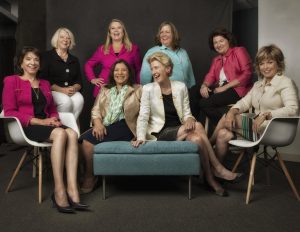
The congressional leaders who are spearheading the charge for a Smithsonian Women’s History Museum. Courtesy American Museum of Women’s History Congressional Commission, via artnet News.
Will the United States Finally Get a National Women’s History Museum? Congress Just Introduced Two Bipartisan Bills to Build One
Susan Collins and Diane Feinstein have teamed up on the Senate bill, while Carolyn Maloney has introduced companion legislation in the House. (artnet News)
The Implicit Punishment of Daring to Go to College When Poor
Only nine percent of people from the lowest income quartile receive a bachelor’s degree by the age of 24, compared to 77 percent for the top income quartile. (New York Times)
Will Artificial Intelligence Make the College Classroom More Accessible?
New tools designed to help institutions meet accessibility requirements could possibly personalize learning for all students. (Education Dive)
Audience Engagement Is Not Community Engagement
An important distinction on two widely used terms. (Americans for the Arts)
Art Institute Postpones Major Native American Pottery Exhibit over Cultural Insensitivity Concerns
The postponement occurs against a backdrop of museums’ increasing sensitivity to the cultures they present. (Chicago Tribune)
This Is How You Kill a Profession
“College faculty were not defeated after great struggle, after a battle with a winner and a loser. College has simply been redefined, over and over, in ways that make faculty irrelevant.” (Chronicle of Higher Ed)
News from the Art and Academic Worlds
posted by CAA — Apr 03, 2019
Want articles like these in your inbox? Sign up: collegeart.org/newsletter
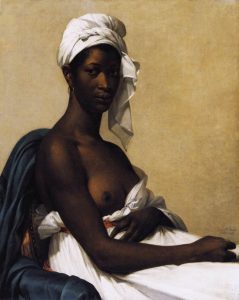
Marie-Guillemine Benoist’s “Portrait of a Negress” (1800) has been retitled “Portrait of Madeleine” for a new exhibition at the Musée d’Orsay. Image: Wikimedia Commons
Musée d’Orsay Puts Focus on Overlooked and Anonymous Black Models in French Masterpieces
The exhibition temporarily retitles works featuring historically anonymous Black models to honor their sitters. (Hyperallergic)
Adjunct Professors at Miami Dade College, America’s Largest Undergrad College, Are Unionizing
The new bargaining unit will include as many as 2,800 workers. (Miami New Times)
Poland’s Right-Wing Government Accused of Hijacking Prize-Winning Museum
One of Poland’s most prominent museums has strongly opposed an attempt by the country’s culture ministry to change its structure. (The Art Newspaper)
Though More Women Are on College Campuses, Climbing the Professor Ladder Remains a Challenge
A look at the numbers from Women in the Academy, a longitudinal study conducted from 2003 to 2012. (Brookings)
This Library Takes an Indigenous Approach to Categorizing Books
Xwi7xwa library in British Columbia is decolonizing the way information is sorted, cataloged, and shared. (Yes Magazine)
To Survive, Small Colleges Are Rethinking the Liberal Arts
As higher ed consolidates, these institutions are restructuring curriculum, campuses, and even tuition. (Education Dive)
See the Results of the 2019 CAA Annual Conference Survey
posted by CAA — Apr 02, 2019
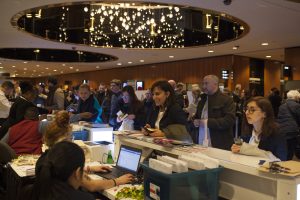
Registration at the 2019 CAA Annual Conference in New York. Photo: Ben Fractenberg
Thank you to everyone who participated in our 2019 Annual Conference survey! Each year we work to make the Annual Conference better than the year before. It’s a large effort that takes the time of many people. We only do it once year but we need to have it perfect from that first hour registration is open, and your direct feedback helps us make that happen.
Here is what you told us about your experience this year:
- Up from last year, 79% of you were satisfied with the Annual Conference
- 75% liked the content of the sessions but only half of you thought the sessions represented a balance of time periods
- 75% liked your online experience with CAA
- 74% liked the Book and Trade Fair
- 67% thought that the conference was welcoming and inclusive
Here’s what you liked about the conference:
- Professional development offerings and workshops
- Networking opportunities
- Diverse sessions, good variety, good from a scholarly point
- Staff—easy to find someone to help
- Very smooth check-in process
- Pay-as-you-Wish Day Pass
- Conference in one building (as opposed to LA)
- New York is a good destination – museums and galleries
- Length of the sessions, committees’ lunch, opportunity to participate on a panel
- Mentoring
- Welcoming and stimulating, not the “high-brow” style of years’ past; friendly, collegial spirit
- More inclusion of design
- Many people got to participate
- Planning features on website
- Childcare
- Book and Trade Fair
- Convocation
- Open sessions on diversity and other topics
- Tables where people could sit and talk
Here is what you want to think about for next year’s conference:
- Conference was too long, and conference fatigue was inevitable
- Need more offerings for mentoring and interviewing
- Bring back the free paper schedule program
- 90-minute sessions are too short for 5 presenters; 8:30 is too early for some sessions
- Too many things are scheduled at the same time
- Too much for art historians rather than artists
- Not enough for art historians
- New York is always a problem with weather and too expensive ($13 for a glass of wine?)
- Could never find the soul to the conference —leaves me feeling sad about our field
- Very few senior scholars or mid-career attended, making it feel like a graduate student mentoring event
- Too many sessions on the same topics and at the same time
- Needs more transparency on how sessions are selected and put together
- There was a lack of diverse topics
- Way too large and overwhelming—no one had a chance to network—conference is no longer an academic one
- Abstracts should be available online
- The website is very confusing
- Too many presenters read from their papers, looking down
- Nothing to attract scholars or historians
- Why are there almost no artists outside of academia at CAA
Here is what you told us about you:
- About 67% of you are art historians; 24% are practicing artists
- 77% of you are associated with a college or university and nearly half of you are either full-time faculty or department chairs
- 75% of you pay for your membership fees yourself; about half of you are fortunate to have your employer to pay for it
Planning to submit a proposal for CAA 2020? The submissions portal for next year’s Annual Conference in Chicago closes April 30. We invite proposals for sessions, lightning rounds, poster sessions, and workshops from visual arts professionals working across the field in all disciplines.
News from the Art and Academic Worlds
posted by CAA — Mar 27, 2019
Want articles like these in your inbox? Sign up: collegeart.org/newsletter

Protesters at the Guggenheim Museum last month dropped white slips of paper symbolizing OxyContin prescriptions. Last week the museum said it would no longer accept money from members of the Sackler family behind the drug. Image: New York Times
Museums Cut Ties With Sacklers as Outrage Over Opioid Crisis Grows
The scrutiny of the Sacklers comes amid a broader reckoning in the museum world about who sits on their boards and bankrolls their programs. (New York Times)
University of Tennessee Will Be Free for Low-Income Students Starting in Fall 2020
The school joins a small—but growing—list of US colleges and universities seeking to make higher education more accessible. (Think Progress)
Study: 40% of Community College Students Take Humanities Classes
Community colleges have seen massive growth in their humanities programs over the past few decades. (Education Dive)
Museums Need to Move with the Times – That’s Why Deaccessioning Isn’t Always Bad News
“Some may view this as pandering to the politically correct. But American art museums have a moral responsibility and historical mandate inscribed in their charters to reach the broadest possible public.” (Apollo Magazine)
$2.8 Million in Met Museum Admission Revenues Will Go to 175 Cultural Nonprofits
NYC officials announced last week that funds from the Met’s change in admissions policy will be redistributed. (Hyperallergic)
Opinion: A Bigger Scandal at Colleges — Underpaid Professors
“What these folks did is not the worst thing happening in our educational system.” (Boston Globe)
News from the Art and Academic Worlds
posted by CAA — Mar 20, 2019
Want articles like these in your inbox? Sign up: collegeart.org/newsletter
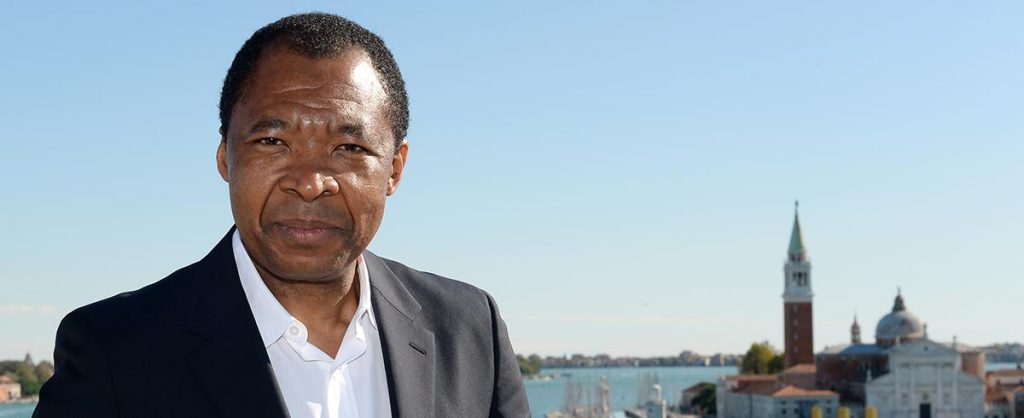
Okwui Enwezor at the Venice Biennale, 2015. Courtesy: La Biennale di Venezia, photo: Giorgio Zuchhiatti via Frieze
Culture Ministers from 16 German States Agree to Repatriate Artifacts Looted in Colonial Era
The ministers agreed to work with museums and institutions to develop repatriation procedures with “the necessary urgency and sensitivity.” (The Art Newspaper)
How Curator Okwui Enwezor (1963-2019) Changed the Course of Art
A tribute to the Nigeria-born poet, critic and curator, who passed away last week at the age of 55. (Frieze)
‘What Does It Take?’: Admissions Scandal Is a Harsh Lesson in Racial Disparities
“This scandal exposed the fact that there is a misplaced emphasis on so-called affirmative action inequities, rather than privilege.” (New York Times)
The Rapid Closure of Art Institutes Across America
Dream Center, a Christian nonprofit with no experience in higher education, has imploded, taking thousands of students—and millions in student loans—down with them. (Hyperallergic)
The Undiscussed Sexual Exploitation Buried in Matisse’s Odalisque Paintings
“So ingrained is exploitation in our understanding of female sexuality within (and outside of) art history that these incredibly basic readings recede into the background and are deemed somehow radical.” (Hyperallergic)
Curator Cuts at Leicester Museums Criticized as Disastrous
Museum leaders in the UK have condemned a cost-cutting proposal to replace curators with an “engagement team.” (The Guardian)
CAA at 2019 Advocacy Days in Washington, DC
posted by CAA — Mar 18, 2019
It’s been a busy month for direct advocacy at CAA! This past month, members of CAA staff attended three national advocacy convenings in Washington, DC: Museums Advocacy Day, Arts Advocacy Day, and Humanities Advocacy Day.
We visited congressional offices to advocate for support for the arts, humanities, and higher education, and continued funding for the NEA, NEH, and IMLS. Our asks also included the reauthorization of the Higher Education Act and support for the Universal Charitable Giving Act and the CREATE Act.
See our on-the-ground updates via Twitter and Instagram.
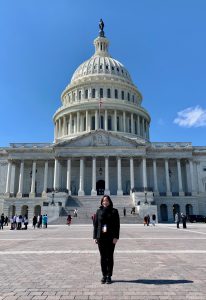
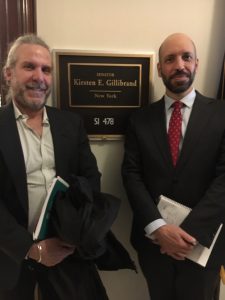
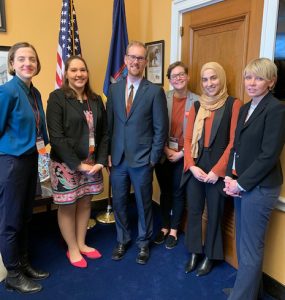
CAA Sponsorship and Partnership Manager Alison Chang; CAA Executive Director Hunter O’Hanian and Legislative Assistant Eric Deeble; CAA Media and Content Manager Joelle Te Paske (far left) and fellow advocates in Rep. Paul Tonko’s office
We visited 15 congressional offices representing four different states, with positive responses from both Democrats and Republicans. We met with staff or dropped off materials with:
Georgia
Rep. Sanford Bishop (D-GA 2nd District)
New York
Rep. Antonio Delgado (D-NY 19th District)
Sen. Kirsten Gillibrand (D-NY)
Rep. Eliot Engel (D-NY 16th District)
Rep. Nita Lowey (D-NY 17th District)
Rep. Sean Maloney (D-NY 18th District)
Rep. Joe Morelle (D-NY 25th District)
Rep. Jerrold Nadler (D-NY 10th District)
Rep. Tom Reed (R-NY 23rd District)
Rep. Kathleen Rice (D-NY 4th District)
Sen. Chuck Schumer (D-NY)
Rep. Paul Tonko (D-NY 20th District)
Rep. Nydia Velazquez (D-NY 7th District)
Oregon
Peter DeFazio (D-OR 4th District)
Texas
Bill Flores (R-TX 17th District)
Learn more about the Advocacy Days below.
View this post on Instagram
MUSEUMS ADVOCACY DAY
February 25-26, 2019
Hosted by American Alliance of Museums
Museum professionals from across the United States gather in Washington, DC, for Museums Advocacy Day. Participants attend sessions outlining key legislative issues affecting the field and meet with their representatives and senators to educate them about the mission of museums and their role in the economy, in adult and child education, and in national culture. Learn more.
ARTS ADVOCACY DAY
March 4-5, 2019
Hosted by Americans for the Arts
Arts advocates from across the country convene in Washington, DC for Americans for the Arts’s annual Arts Advocacy Day each year. Arts Advocacy Day brings together a broad cross section of America’s cultural and civic organizations, along with more than 700 grassroots advocates from across the country, to underscore the importance of developing strong public policies and appropriating increased public funding for the arts. Learn more.
HUMANITIES ADVOCACY DAY
March 11-12, 2018
Hosted by National Humanities Alliance
Humanities Advocacy Day provides the opportunity to connect with a growing number of humanities advocates from around the country. Together, advocates will explore approaches to year-round advocacy on college campuses and in local communities while also preparing for Capitol Hill visits. On March 12, they will visit House and Senate offices to make a persuasive case for federal funding for the humanities. Learn more.
For more on CAA’s advocacy efforts, click here.
We encourage you to be vocal about your support for the arts and humanities. Click here to access the CAA Arts and Humanities Advocacy Toolkit.
Meet Cali Buckley, CAA’s New Grants and Special Programs Manager
posted by CAA — Mar 14, 2019
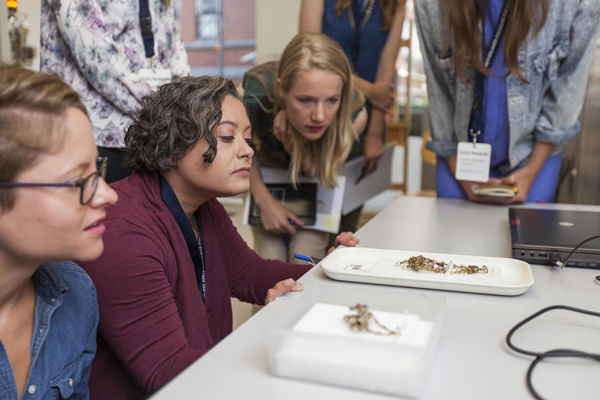
Cali Buckley takes part in the Rijksmuseum’s Museum Objects as Evidence: Approaches to the Material World Summer School, 2018. Photo: Thijs Gerbrandy
We’re delighted to introduce Cali Buckley, CAA’s new Grants and Special Programs Manager and RAAMP Coordinator, who began her full-time role in January after working part-time as the CAA Programs Assistant in 2017. She received her PhD from Penn State University on interactive anatomical models and their creation by craftsmen in the early modern era. Joelle Te Paske, CAA Media and Content Manager, spoke with her in late January to learn more about her research and her hopes for the Resources for Academic Art Museum Professionals (RAAMP) program, which provides publicly accessible resources to academic museum professionals.
Joelle Te Paske: Thanks for taking the time to chat, Cali. So to begin, where are you from?
Cali Buckley: I’m from Pottsville, Pennsylvania. It’s only about three hours from here. It’s north of Philly, best known for Yuengling beer which is the oldest brewery in America. That’s our claim to fame.
JTP: Good to know. And you worked with CAA a few years ago, correct?
CB: Yes, I moved to New York after my Fulbright and worked for CAA for six months as a programs assistant part-time while I was finishing my dissertation. Once I defended and graduated, I moved back to Germany.
I actually have long ties with CAA. Right out of college, I worked for Penn State University Press on art history books. I was able to actually attend CAA and talk to authors, and I worked at the Book and Trade Fair for about three years. It was fun. You can hear people talking about their wonderful book ideas. If I had more time, I would just sit around and see how people pitch these things because it’s fascinating.
I went to Penn State for journalism and then went into publishing right after graduating—I worked on history books and then got really into art history and thought about all the possibilities. Because I guess I had this much narrower idea of traditional art history. And then working on some of these new books really expanded my sense of what that could be.
JTP: That’s great.
CB: I knew some folks in our art history department at Penn State through the editorial board, and I started talking to them about the possibility of my doing my masters there. And I met one of my professors through an editor there. So I planned on going for my masters and then back into publishing, but I completely fell in love with it. I found some great topics, and I just kind of wanted to keep moving forward.
I started going to CAA as a graduate student, so no longer in the Book and Trade Fair. I was part of this group called The Graduate Student Association for Visual Culture. And we would apply for money from Penn State to get groups of us to go to CAA every year. So we would have this group caravan to CAA, all the art historians.
JTP: Sounds ideal.
CB: It’s wonderful. We created this Valentine’s Day tradition because CAA usually falls over Valentine’s Day. And we still get together on the 14th and watch our favorite movie and eat pizza.
JTP: Are you going to do it this year?
CB: Yes, yes, absolutely.
So I started with doing the Book and Trade Fair at CAA. Then I went as a graduate student, gave a talk at CAA in Chicago a few years back. And the same day participated in a roundtable in publishing. CAA’s been huge in my life.
JTP: I’d love to speak a bit about your research, too—early anatomical models and the control of women in medicine.
CB: Originally, when I went into publishing, I was doing weird research projects on interactive books and books as objects. And I used to give talks at Columbia to journalism students in the summer about how to create physical books and how it’s different from books online. How to work with the movement of books and do all these funny things that literary magazines were experimenting with. And then I found this sixteenth-century version of what I was talking about, in the form of an anatomical model.
These have become much more popular in the last ten years but some of these [models] had layers. So they were just images of the body with layers showing the different organs and systems. And that idea of movement and interactivity was fascinating—and a lot of them are inaccurate, even for their time, which makes them even more interesting.
There are all these different layers to audiences, whether you’re trying to highlight the accuracy, which a lot of these are not, or the visuality and the interactivity. And that seems to be more important.
Then I got into ivory models, which is a huge project of mine, creating a whole catalogue of them. That’s a big part of my dissertation.
JTP: Interesting.
CB: I found 180 in the world and I have new people emailing me every year. They’re a much bigger phenomenon than we thought and I’ve done quite a bit of research in Germany to pull these threads together and find out more about their history. I’ve been trying to bring these to light and hopefully I’ll have an article out soon.
JTP: That’s terrific. I’m curious—what is one of your favorite CAA conference memories?
CB: I think one of the great memories was actually an event connected to CAA where I was giving a talk with someone from The Art Institute of Chicago and they let us do a private showing of prints and different objects [at the museum]. Some of the prints were the actual interactive prints that I had worked on.
JTP: That’s always exciting, to be in the same room with objects you’ve studied.
Do you have a favorite exhibition you’ve seen recently?
CB: I just went to the Brueghel exhibition in Vienna and it was amazing. I mean, it was really well done and it went through both his history and paintings and a lot of his earlier drawings and sketches. But it also included a lot of the process to make the materials—some of the wooden planks and those sorts of thing that he used, and the process of painting and printing. That process stuff was really interesting. I think that should be in a lot more exhibitions.
JTP: I agree. My first job was as a registrar at a gallery and I can never quite divorce myself from “How much did the crate cost?”! Because you have a different sense of the process.
CB: Absolutely. I work a lot on materiality. I’m interested in the process of how a work was made, what it’s made of, and how the material affects it. I actually started taking a lot more art classes in different areas to get a feel for it.
I took a class in wax modeling with someone who does wax moulages and restoration. Moulages are generally medical things. So I essentially made a moulage using wax of some skin condition! That was a fun workshop. I was at the Narrenturm which is an old insane asylum in Vienna that now houses a pathological museum. And then you spend a couple of hours making these wax moulages. It was just such a bizarre and wonderful day.
JTP: That does sound bizarre and wonderful.
So, thinking forward to your work with RAAMP, what do you find the most exciting part of that resource?
CB: I’m excited to be [at CAA] and working on a diversity of projects so that I get that bigger, that broader umbrella of what’s new and exciting outside of my little area of the research world. Part of that is the RAAMP program, which really allows people in various facets of the academic and museum worlds to share experiences and have discussions about issues facing those institutions—and those who they serve—today. I love the idea of having meetings and sharing discussions online, because that way they are more accessible. Our Coffee Gatherings are like afternoon meetings at a café with a small audience that can discuss matters in a casual way, but they are also recorded now so students can always watch these later to gain insight into particular matters. The video practica are similar, but more streamlined with one person discussing a specific topic. I can’t wait to get more Coffee Gatherings together because those small group discussions can be really valuable.
JTP: How do you see of the role of academic art museums moving forward?
CB: Academic art museums are as integral as ever to education, but they are facing different issues as time goes on while also dealing with age-old dilemmas. They need to learn how to use the latest technology and how to deal with the latest controversies over artwork, but they also need to engage students. The whole idea of RAAMP is to provide resources for academic art museums to tackle these problems. Part of that is providing a network of professionals who share their expertise.
I do think that museums have to be aware of the social environment and how to contend with criticism. Our session at the 2019 conference allows us to open up this topic to see how artists and professionals deal with some very serious issues of artwork being interpreted as offensive. Artwork is inherently open to interpretation, so I think it’s important to discuss how museums act as mediators to a degree—and how their role is balanced with their place in an academic institution.
I should add that one of my favorite teaching experiences was being able to introduce first-year students to the Palmer Museum of Art at Penn State and asking them to describe the giant [Helen] Frankenthaler painting we had hanging there. There’s nothing quite like it when a student realizes that they have history right in front of them.
Announcing CAA Publication Fund Award Winners
posted by CAA — Mar 13, 2019
2019 TERRA FOUNDATION FOR AMERICAN ART INTERNATIONAL PUBLICATION GRANT WINNERS
CAA is pleased to announce the 2019 recipients of the Terra Foundation for American Art International Publication Grant. This program, which provides financial support for the publication of book-length scholarly manuscripts in the history of American art, is made possible by a generous grant from the Terra Foundation for American Art. For this grant, “American art” is defined as art (circa 1500–1980) of what is now the geographic United States.
 The ten Terra Foundation grantees for 2019 are:
The ten Terra Foundation grantees for 2019 are:
- Anni Albers, On Weaving, translation in French, Les Presses du Réel
- Anna Arabindan-Kesson, Black Bodies, White Gold: Art, Cotton and Commerce in the Atlantic World, Duke University Press
- François Brunet, La naissance de l’idée de photographie [The Birth of the Idea of Photography], translation from French into English, Ryerson Image Center
- Julia Bryan-Wilson, Art Workers: Radical Practice in the Vietnam War Era, translation in Korean, Youlhwadang Press
- Eddie Chambers, ed., The Routledge Companion to African American Art History, Taylor & Francis
- Julia Drost, ed., Networks, Museums and Collections. Surrealism in the U.S., translation from French to English, Deutsches Forum für Kunstgeschichte Paris
- Natilee Harren, Fluxus Forms: Scores, Multiples and the Eternal Network, University of Chicago Press
- Elaine de Larminat, Houses and Homes. Photographier la maison américaine, Le Point du Jour
- Jody Patterson, Modernism for the Masses: Painters, Politics, and Public Murals in New Deal New York, Yale University Press
- Laurence Schmidlin, La spatialisation du dessin dans l’art américain des années 1960 et 1970, Les Presses du Réel
The International Author Conference Subventions confer two non-US authors of top-ranked books travel funds and complimentary registration to attend CAA’s 2020 Annual Conference in Chicago, February 12-15; they also received one-year CAA memberships.
The two author awardees for 2019 are:
- Elaine de Larminat
- Laurence Schmidlin
See a list of recent recipients
2018 WYETH AWARD WINNERS
Since 2005, the Wyeth Foundation for American Art has supported the publication of books on American art through the Wyeth Foundation for American Art Publication Grant, administered by CAA. For the grant, “American art” is defined as art created in the United States, Canada, and Mexico.
The 2018 grantees are:
- Bellion, Wendy, The Great Fall: Iconoclasm in New York City since the American Revolution (Penn State University Press)
- Boone, M. Elizabeth, “The Spanish Element in Our Nationality”: Spain and America at the World’s Fairs and Centennial Celebrations, 1876-1915 (Penn State University Press)
- Coffey, Mary, Orozco’s American Epic: Myth, History, and the Melancholy of Race (Duke University Press)
- Deloria, Philip, Becoming Mary Sully: Toward an American Indian Abstract (University of Washington Press)
- Diack, Heather, Marks of Contingency: The Photographic Conditions of Conceptual Art (University of Minnesota Press)
- Jentleson, Katherine, Gatecrashers: The Rise of the Self-Taught Artist in America (University of California Press)
- Monahan, Anne, Horace Pippin, American Modern (Yale University Press)
- Senf, Rebecca A., Making a Photographer: The Early Work of Ansel Adams (Yale University Press)
- Strathman, Nicole D., Through a Native Lens: American Indian Photography (University of Oklahoma Press)
- Taylor, Sue, Grant Wood’s Secrets (University of Delaware Press)
See a list of recent recipients
FALL 2018 MEISS FUND RECIPIENTS 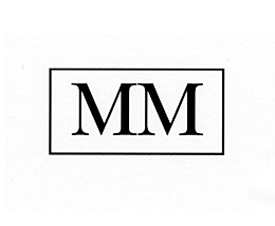
Twice a year, CAA awards grants through the Millard Meiss Publication Fund to support book-length scholarly manuscripts in the history of art, visual studies, and related subjects that have been accepted by a publisher on their merits, but cannot be published in the most desirable form without a subsidy. Thanks to the generous bequest of the late Prof. Millard Meiss, CAA began awarding these publishing grants in 1975.
The Millard Meiss Publication Fund grantees for Fall 2018 are:
- Amstutz, Nina, Caspar David Friedrich: Landscape, Science, and the Self, (Yale University Press)
- Campbell, Aurelia, Architecture and Empire in the Reign of Yongle, 1402-1424, (University of Washington Press)
- Chanchani, Nachiket, Mountain Temples and Temple Mountains: Architecture, Religion, and Nature in the Central Himalayas, (University of Washington Press)
- Deloria, Philip, Becoming Mary Sully: Toward an American Indian Abstract, (University of Washington Press)
- Gerschultz, Jessica, Decorative Arts of the Tunisian École: Fabrications of Modernism, Gender, and Power, (Penn State University Press)
- Mahon, Alyce, The Sadean Imagination: The Marquis de Sade, Terror, and the Avant-Garde (Princeton University Press)
- McDowell, Tara, The Householders: Robert Duncan and Jess, (MIT Press)
- Tsultemin, Uranchimeg, A Monastery on the Move: Art and Politics in Later Buddhist Mongolia, (University of Hawai‘i Press)
See a list of recipients from 1975 to the present
CONTACT
Questions? Please contact Cali Buckley, CAA grants and special programs manager, at 212-392-4435.


